Washington Kurdish Institute
By: Cameron Sterling & Yousif Ismael
Introduction
The Turkish invasion and occupation of the Kurdish region of Syria, initiated in 2016 through multiple phases, has inflicted significant harm on the lives of civilians and military personnel.
In October 2019, the Turkish government launched a new campaign, prompting the partial withdrawal of US forces from areas controlled by the International Coalition. However, public pressure and the concern that the US was betraying its Kurdish allies drove the Trump Administration to change its position on US withdrawal. On October 17, 2019, Vice President Mike Pence, announced a peace accord with Ankara, intended to put an end to the Turkish invasion and maintain a US presence. Shortly after, Turkish President Recep Tayyip Erdogan traveled to Sochi for discussions with his Russian counterpart, Vladimir Putin. The outcome of these talks was an agreement on October 22, ceasing the Turkish invasion.
Despite formal agreements reached with the US and Russia in late 2019, the Turkish government has persisted in its hostilities against the Kurdish-led Autonomous Administration of North and East of Syria (AANES) under dubious pretexts.
This research documents the civilian victims of Turkey’s and aligned armed factions’ attacks in AANES controlled areas from the outset of 2020 – just after the peace agreement – until August 2023, primarily within the context of the Kurdish population. These casualties encompass those resulting from airstrikes, artillery fire, and the use of small arms.
Data Sources
Our analysis relies heavily on data provided by Airwars (airwars.org), supplemented by information from the Rojava Information Center (rojavainformationcenter.com) as well as several press outlets. The accuracy of the attacks has been verified by the Washington Kurdish Institute (WKI).
Important Notes
This analysis is specifically focused on the geographical regions under the governance of the AANES. Some of the coordinates are approximate, not the precise locations of the attacks. However, it’s important to note that the following data excludes:
- Civilian casualties caused by Turkish border guards, estimated to be in the dozens.
- Military casualties within the Syrian Democratic Forces (SDF), which are estimated to be in the thousands.
- Military casualties within the Syrian Regime forces
While the WKI has verified our reporting on Turkish and its Syrian affiliated armed groups’ attacks on civilians to the best of our abilities, the data presented is only as exhaustive as the press reporting we have relied on to compile this webpage.
Interactive Map Showing Locations of Attacks
Total Killed and Wounded Civilians
The table presented below shows the total civilian casualties. From the data presented in the following figures, it is clear that Turkish attacks in AANES controlled areas have systematically caused harm to civilians, killing 114 and injuring another 348 individuals since 2020.
Turkey has broken international commitments to cease its invasion of Northern Syria without any regard to civilian wellbeing. While the increase in civilian victims seemed to slow in 2021, Turkish attacks affected more people in 2022 than 2020, just after the peace accord was signed. It is on track to do the same in 2023.
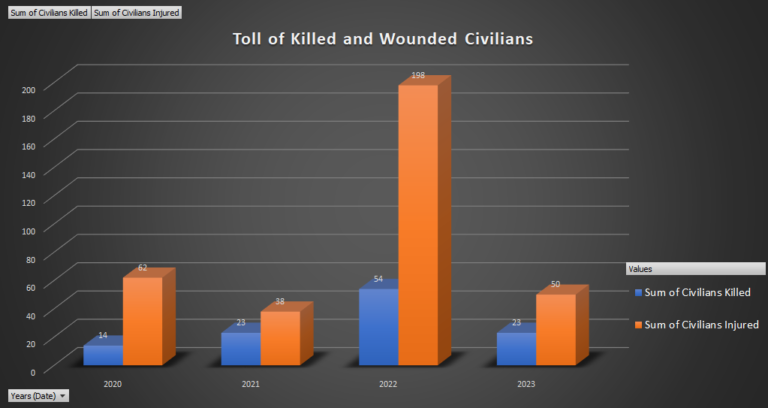

Women and Children
Turkey’s and aligned armed factions’ attacks against AANES controlled areas have harmed all segments of the population, including marginalized groups like women and children. In Syria, over a third of the population is under the age of 14. In some areas controlled by AANES, youth make up over half of the population. After years of war, women drastically outnumber men. All of this is to say that Turkey’s style of near-indiscriminate air and artillery strikes is directed towards a population made up largely of vulnerable groups. Children have made up 34% of civilian deaths caused by Turkish strikes in AANES controlled areas and 18% of those injured. Women have accounted for 21% of deaths and close to 11% of those injured.
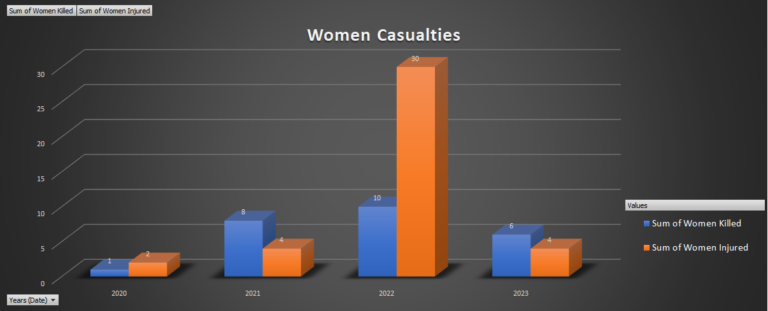

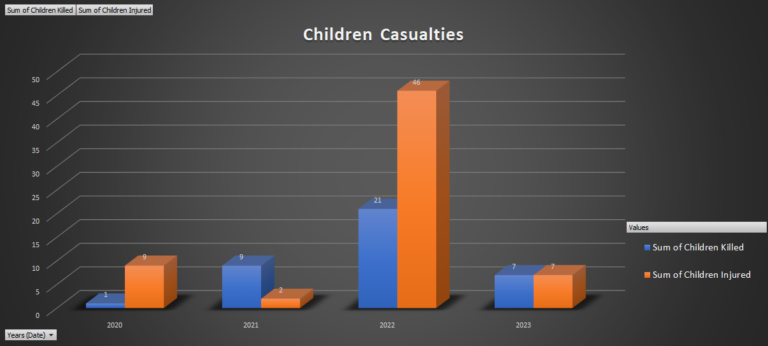

Geographic Distribution
Turkish strikes in AANES controlled areas have concentrated in al-Raqqa and al-Hasakah provinces, clustering on the border between Turkey and Syria, as visualized in the figure below. Comparison with a map of populated areas in the north and east of Syria shows that Turkey is targeting highly-settled areas with large civilian populations.
Interactive Map Showing Syria’s Population Density

The Switch to Drones
Another insight that the WKI has garnered from this data is Turkey’s increasing use of drone attacks. While many argue that drone attacks offer a less deadly alternative to traditional artillery, our data shows that in AANES controlled areas, drones exacerbated the harm caused by Turkey towards civilian populations. “Civilian Victims by Type of Attack in Northern Syria From 2020 to August 2023” visualizes this, showing that Turkey’s use of drones starting in 2021 has increased civilian harm caused, without making a dent in the artillery attacks conducted by Turkish or affiliated combatants. Instead of supplementing artillery with a less deadly style of warfare, drones have led to a steady increase in civilian harm.
Airstrikes have proven to be more deadly towards the civilian population. As shown in “The Deadliness of Airstrikes and Artillery Attacks,” airstrikes have proportionately been more deadly for civilians affected, causing more total deaths than artillery. Following current trends, airstrikes will soon outpace artillery in the number of civilians affected in total.
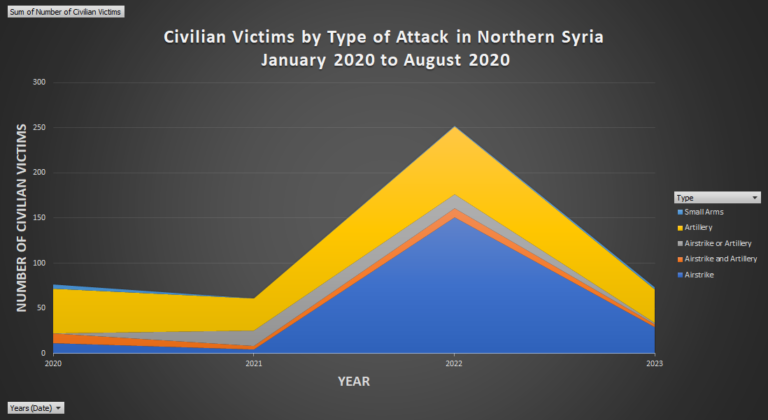
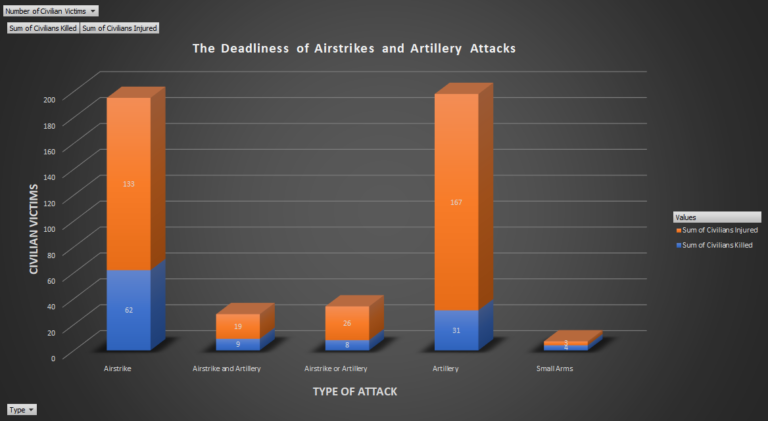
Conclusion
Turkey stands as a significant contributor to the destabilization within the region, notably due to the civilian casualties they cause. At the same time, Turkey hinders the fight against ISIS. This is evidenced by their targeting of US-backed forces, which have proven to be the most effective entities in combating terrorist groups and advancing American interests in the country.
Turkey’s strategic focus on the north and east of Syria further exacerbates the displacement and migration crises among the populace, particularly impacting the Kurdish communities. These actions perpetuate a cycle of upheaval and unrest, disrupting the lives of countless innocent civilians.
Compounding the situation, Turkey’s activities inadvertently bolster adversaries of the United States, including the Assad regime, Iranian militias, and Russia. This strengthens the triumvirate’s efforts to assert control over the AANES and reinstate Assad’s authoritarian rule.
